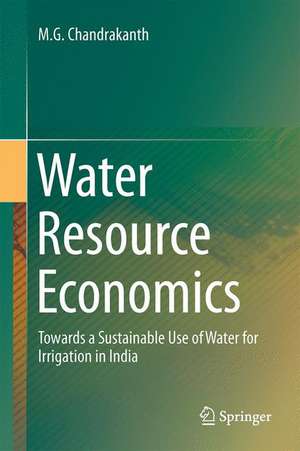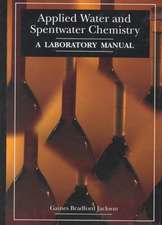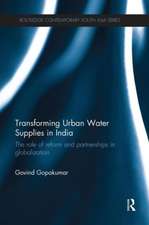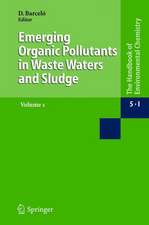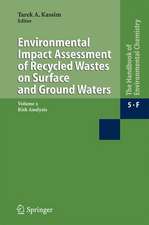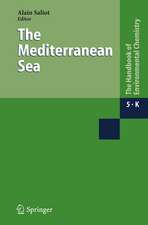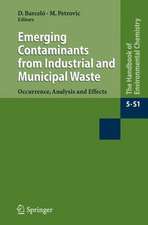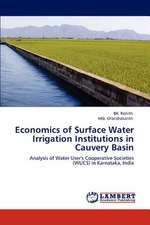Water Resource Economics: Towards a Sustainable Use of Water for Irrigation in India
Autor M. G. Chandrakanthen Limba Engleză Hardback – 14 oct 2015
Despite water’s vital role in ensuring economic security for the nation and farmers alike by supporting more than 70% of food production, water resource economists are yet to impress upon farmers and policymakers the true value of water and the urgent need for its sustainable extraction, recharge and use. In an endeavor to promote more awareness, the book further delineates the roles of the demand side and supply side in the economics of irrigation, and explains how the cost of water varies with the efforts to recharge it, crop patterns, degrees of initial and premature well failure and degrees of externalities. It also discusses the importance of micro-irrigation in the economics of saving water for irrigation, estimating the marginal productivity of water and how it improves with drip irrigation, the economics of water sharing and water markets, optimal control theory in sustainable extraction of water, payment of ecosystem services for water and how India can effectively recover.
In closing, the book highlights the role of socioeconomic and hydrogeological factors in the economics of irrigation, which vary considerably across hard rock areas and the resulting limitations on generalizing.
| Toate formatele și edițiile | Preț | Express |
|---|---|---|
| Paperback (1) | 385.84 lei 43-57 zile | |
| Springer India – 23 aug 2016 | 385.84 lei 43-57 zile | |
| Hardback (1) | 393.13 lei 43-57 zile | |
| Springer India – 14 oct 2015 | 393.13 lei 43-57 zile |
Preț: 393.13 lei
Nou
Puncte Express: 590
Preț estimativ în valută:
75.25€ • 81.76$ • 63.25£
75.25€ • 81.76$ • 63.25£
Carte tipărită la comandă
Livrare economică 21 aprilie-05 mai
Preluare comenzi: 021 569.72.76
Specificații
ISBN-13: 9788132224785
ISBN-10: 8132224787
Pagini: 179
Ilustrații: XLI, 212 p.
Dimensiuni: 155 x 235 x 20 mm
Greutate: 0.54 kg
Ediția:1st ed. 2015
Editura: Springer India
Colecția Springer
Locul publicării:New Delhi, India
ISBN-10: 8132224787
Pagini: 179
Ilustrații: XLI, 212 p.
Dimensiuni: 155 x 235 x 20 mm
Greutate: 0.54 kg
Ediția:1st ed. 2015
Editura: Springer India
Colecția Springer
Locul publicării:New Delhi, India
Public țintă
ResearchCuprins
1. Water for Irrigation: An overview.- 2. Externality in Irrigation.- 3. Unidirectional and Reciprocal externality in irrigation.- 4. Sand Mining Externality.- 5. Relationship between rainfall and recharge.- 6. Marginal productivity of Water.- 7. Costing water for irrigation.- 8. Locating interference and valuing water.- 9. Demand side economics of Micro irrigation.- 10. Supply side economic contribution watershed program to groundwater recharge.- 11. Water markets.- 12. Sustainable path of extraction of Ground water in tank and canal command areas.- 13. Water Policy.- 14. Payment for ecosystem services (PES) for water.- 15. Economics of artificial recharge of borewell in hard rock areas.
Recenzii
“Book under review is a timely and most comprehensive assessment of water and its use in agriculture. … Chandrakanth, has done a remarkable job of weaving the hydrological, economic and institutional aspects of water use into a meaningful and complete product. … hydrological concepts, empirical analyses and policy discussions found in this book could very well be applied to agricultural water use decisions and policies in other parts of India and even other parts of the world with suitable adjustments.” (Mahadev G. Bhat, Current Science, Vol. 111 (2), July, 2016)
Notă biografică
MG Chandrakanth is currently Professor and University Head of Agricultural Economics and former Dean of College of Agriculture, University of Agricultural Sciences Bangalore (UASB), India. He completed BSc (Agri) in 1974, MSc (Agri) in Agricultural Economics in 1976 under Professor Noel SP Rebellow, and obtained his PhD in Agricultural Economics in 1981 under Dr JV Venkataram from the UASB. He served the Institute for Social and Economic Change, Bangalore, India, as Assistant Professor in the Rural Economics Unit from 1982-1983 and joined the UASB as Associate Professor in 1983. He has been teaching agricultural economics, production economics, mathematical economics, advanced micro economics, institutional economics and history of economic thought, natural resource and environmental economics courses.
Dr. Chandrakanth pursued post doctoral studies with fellowship from the Ford Foundation, USA in forest resource economics in 1987-1988. He was awardedthe Ciriacy-Wantrup Post Doctoral Fellowship for 1988-1990 period, in institutional economics of natural resources at the University of California, Berkeley, USA and worked under Prof Jeff Romm specializing in water resource economics and policy.
He was nominated Vice President of the Indian Society of Agricultural Economics in 2000 and as member of Editorial board of the Indian Journal of Agricultural Economics in 2012. He facilitated student exchange program with the University of Gent with Prof Guido Van Huylenbroeck in Rural Development (IMRD) and was Erasmus Mundus visiting scholar, University of Ghent, Belgium in 2008; DAAD scholar at Humboldt University, Berlin 2010 and 2012. He is a member of the Water Policy Law Group of the University of South Australia, Adelaide, Australia. Dr. Chandrakanth was awarded the Fellow of the Indian Society of Agricultural Economics in 2013 and Dr Ramesh Chandra Agrawal Award of excellence for his outstanding contributions in Agricultural Economics in 2014. He has published in Natural Resources Journal, Natural Resources Forum, Ecological Economics, Water Policy, Environment and Development Economics, Economic and Political Weekly, Ind Jr of Agri Economics, Agricultural Economics Research Review (http://www.toenre.com/). He handled projects funded by the Ford Foundation from 1995 to 2005 on Groundwater resource economics and has been the leader of the Team of Excellence in Natural Resource Economics since 2000. Dr Chandrakanth is a student and admirer of Professors R. Ramanna, S Bisaliah, HS Krishnaswamy, HG Shankaramurthy, NSP Rebellow, KN Ranganatha Sastry, MV Nadkarni, VM Rao, K Palanisami and RS Deshpande for their academic
excellence and commitment to teaching and is attempting to tread his path on similar lines with his passion for teaching and research in agricultural economics.
Dr. Chandrakanth pursued post doctoral studies with fellowship from the Ford Foundation, USA in forest resource economics in 1987-1988. He was awardedthe Ciriacy-Wantrup Post Doctoral Fellowship for 1988-1990 period, in institutional economics of natural resources at the University of California, Berkeley, USA and worked under Prof Jeff Romm specializing in water resource economics and policy.
He was nominated Vice President of the Indian Society of Agricultural Economics in 2000 and as member of Editorial board of the Indian Journal of Agricultural Economics in 2012. He facilitated student exchange program with the University of Gent with Prof Guido Van Huylenbroeck in Rural Development (IMRD) and was Erasmus Mundus visiting scholar, University of Ghent, Belgium in 2008; DAAD scholar at Humboldt University, Berlin 2010 and 2012. He is a member of the Water Policy Law Group of the University of South Australia, Adelaide, Australia. Dr. Chandrakanth was awarded the Fellow of the Indian Society of Agricultural Economics in 2013 and Dr Ramesh Chandra Agrawal Award of excellence for his outstanding contributions in Agricultural Economics in 2014. He has published in Natural Resources Journal, Natural Resources Forum, Ecological Economics, Water Policy, Environment and Development Economics, Economic and Political Weekly, Ind Jr of Agri Economics, Agricultural Economics Research Review (http://www.toenre.com/). He handled projects funded by the Ford Foundation from 1995 to 2005 on Groundwater resource economics and has been the leader of the Team of Excellence in Natural Resource Economics since 2000. Dr Chandrakanth is a student and admirer of Professors R. Ramanna, S Bisaliah, HS Krishnaswamy, HG Shankaramurthy, NSP Rebellow, KN Ranganatha Sastry, MV Nadkarni, VM Rao, K Palanisami and RS Deshpande for their academic
excellence and commitment to teaching and is attempting to tread his path on similar lines with his passion for teaching and research in agricultural economics.
Textul de pe ultima copertă
This book uses resource economics costing approaches incorporating externalities to estimate the returns for the country’s irrigation, and demonstrates how underestimating the cost of water leads farmers to overestimate profits. The importance of the subject can be judged in light of the fact that India is the largest user of groundwater both for irrigation and for drinking purposes, pumping twice as much as the United States and six times as much as Europe.
Despite water’s vital role in ensuring economic security for the nation and farmers alike by supporting more than 70% of food production, water resource economists are yet to impress upon farmers and policymakers the true value of water and the urgent need for its sustainable extraction, recharge and use. In an endeavor to promote more awareness, the book further delineates the roles of the demand side and supply side in the economics of irrigation, and explains how the cost of water varies with the efforts to recharge it, croppatterns, degrees of initial and premature well failure, and degrees of externalities. It also discusses the importance of micro-irrigation in the economics of saving water for irrigation, estimating the marginal productivity of water and how it improves with drip irrigation, the economics of water sharing and water markets, optimal control theory in sustainable extraction of water, payment of ecosystem services for water, and how India can effectively recover.
In closing, the book highlights the role of socioeconomic and hydrogeological factors in the economics of irrigation, which vary considerably across hard rock areas, and the resulting limitations on generalizing.
Despite water’s vital role in ensuring economic security for the nation and farmers alike by supporting more than 70% of food production, water resource economists are yet to impress upon farmers and policymakers the true value of water and the urgent need for its sustainable extraction, recharge and use. In an endeavor to promote more awareness, the book further delineates the roles of the demand side and supply side in the economics of irrigation, and explains how the cost of water varies with the efforts to recharge it, croppatterns, degrees of initial and premature well failure, and degrees of externalities. It also discusses the importance of micro-irrigation in the economics of saving water for irrigation, estimating the marginal productivity of water and how it improves with drip irrigation, the economics of water sharing and water markets, optimal control theory in sustainable extraction of water, payment of ecosystem services for water, and how India can effectively recover.
In closing, the book highlights the role of socioeconomic and hydrogeological factors in the economics of irrigation, which vary considerably across hard rock areas, and the resulting limitations on generalizing.
Caracteristici
Provides insights into resource economics aspects of groundwater and creates awareness regarding the sustainable use of this scarce resource Offers a primer helping students and policymakers to understand methods for the efficient extraction and use of groundwater Discusses efficient use of water in connection with crops, well capacities and agro-climatic areas
